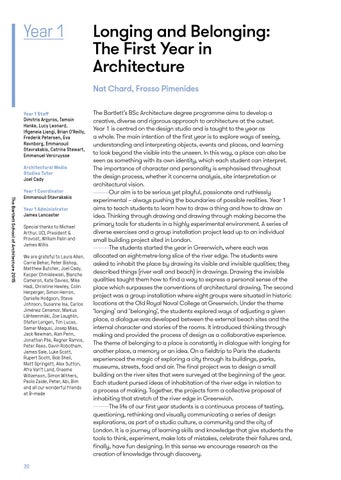Year 1
Longing and Belonging: The First Year in Architecture Nat Chard, Frosso Pimenides
Year 1 Staff Dimitris Argyros, Tamsin Hanke, Lucy Leonard, Ifigeneia Liangi, Brian O’Reilly, Frederik Petersen, Eva Ravnborg, Emmanouil Stavrakakis, Catrina Stewart, Emmanuel Vercruysse Architectural Media Studies Tutor Joel Cady
The Bartlett School of Architecture 2015
Year 1 Coordinator Emmanouil Stavrakakis Year 1 Administrator James Lancaster Special thanks to Michael Arthur, UCL President & Provost, William Palin and James Willis We are grateful to Laura Allen, Carrie Behar, Peter Bishop, Matthew Butcher, Joel Cady, Kacper Chmielewski, Blanche Cameron, Kate Davies, Mike Hadi, Christine Hawley, Colin Herperger, Simon Herron, Danielle Hodgson, Steve Johnson, Susanne Isa, Carlos Jiménez Cenamor, Markus Lähteenmäki, Zoe Laughlin, Stefan Lengen, Tim Lucas, Samar Maqusi, Josep Miàs, Jack Newman, Alan Penn, Jonathan Pile, Regner Ramos, Peter Rees, Gavin Robotham, James Sale, Luke Scott, Rupert Scott, Bob Sheil, Matt Springett, Alex Sutton, Afra Van’t Land, Graeme Williamson, Simon Withers, Paolo Zaide, Peter, Abi, Bim and all our wonderful friends at B-made
30
The Bartlett’s BSc Architecture degree programme aims to develop a creative, diverse and rigorous approach to architecture at the outset. Year 1 is centred on the design studio and is taught to the year as a whole. The main intention of the first year is to explore ways of seeing, understanding and interpreting objects, events and places, and learning to look beyond the visible into the unseen. In this way, a place can also be seen as something with its own identity, which each student can interpret. The importance of character and personality is emphasised throughout the design process, whether it concerns analysis, site interpretation or architectural vision. Our aim is to be serious yet playful, passionate and ruthlessly experimental – always pushing the boundaries of possible realities. Year 1 aims to teach students to learn how to draw a thing and how to draw an idea. Thinking through drawing and drawing through making become the primary tools for students in a highly experimental environment. A series of diverse exercises and a group installation project lead up to an individual small building project sited in London. The students started the year in Greenwich, where each was allocated an eight-metre-long slice of the river edge. The students were asked to inhabit the place by drawing its visible and invisible qualities; they described things (river wall and beach) in drawings. Drawing the invisible qualities taught them how to find a way to express a personal sense of the place which surpasses the conventions of architectural drawing. The second project was a group installation where eight groups were situated in historic locations at the Old Royal Naval College at Greenwich. Under the theme ‘longing’ and ‘belonging’, the students explored ways of adjusting a given place, a dialogue was developed between the external beach sites and the internal character and stories of the rooms. It introduced thinking through making and provided the process of design as a collaborative experience. The theme of belonging to a place is constantly in dialogue with longing for another place, a memory or an idea. On a fieldtrip to Paris the students experienced the magic of exploring a city through its buildings, parks, museums, streets, food and air. The final project was to design a small building on the river sites that were surveyed at the beginning of the year. Each student pursed ideas of inhabitation of the river edge in relation to a process of making. Together, the projects form a collective proposal of inhabiting that stretch of the river edge in Greenwich. The life of our first year students is a continuous process of testing, questioning, rethinking and visually communicating a series of design explorations, as part of a studio culture, a community and the city of London. It is a journey of learning skills and knowledge that give students the tools to think, experiment, make lots of mistakes, celebrate their failures and, finally, have fun designing. In this sense we encourage research as the creation of knowledge through discovery.
